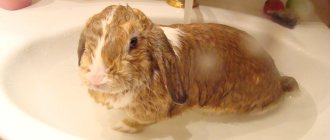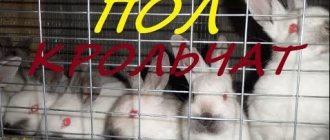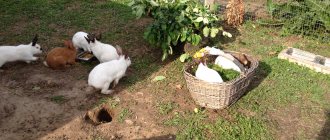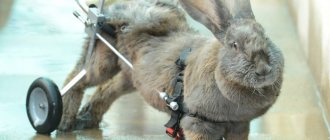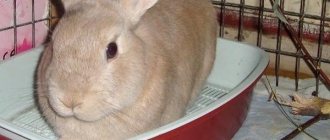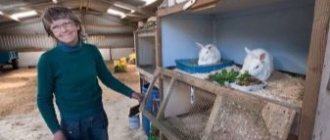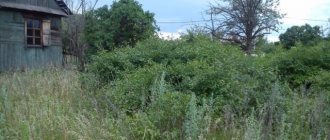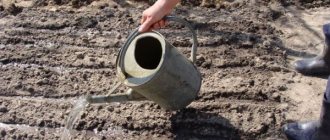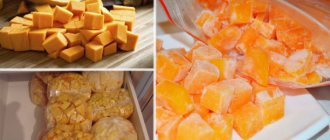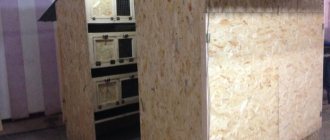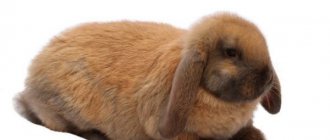Breeding fluffy eared animals is an interesting activity that brings a lot of profit - meat and skins. But to get them, rabbit breeders must face the slaughter process - be able to slaughter and properly cut up a rabbit.
High-quality products come out only if you follow all the subtleties of slaughter and do not cause a lot of pain to the animal itself. The process may not seem very pleasant psychologically, but there is no way to do without it. If you know all the nuances, and also take into account the recommendations of experienced breeders, then you can slaughter without complications.
How to determine the right time for slaughter
To choose the optimal time for slaughtering rabbits, you need to focus on their physiological development:
- Choose the time when rabbits reach 1.5 kg in weight or gain peak body weight according to breed characteristics.
- Slaughter after molting.
- After vaccination, it is recommended to send animals for consumption 30 days after the vaccination procedure.
- Slaughter for meat. To obtain only meat, you can slaughter a rabbit any day after it has gained the required body weight.
- To obtain skins. To obtain high-quality skins, you need to follow the shedding pattern. If you kill a rabbit while replacing the coat, the resulting product will lose its appearance over time - most of the fibers will come out of it. Therefore, young rabbits born in winter are slaughtered at 4 months of age, and those born in summer usually begin to be killed in November, when molting is completely completed. Skins obtained during this period are considered to be of the highest quality and most expensive. Animals that have completely faded have a uniform white skin color. For breeds of dark colors, light gray or bluish-white skin is allowed.
It’s very easy to check whether the molt is over.
It is necessary to pluck out a few hairs from the animal's thigh. It will be very difficult to remove the villi from completely shed individuals. With active molting, the hairs themselves easily fall off when stroking, and redness is noticeable on the skin in faded areas. Rabbit skins after the very first molt are not thick and dense, and therefore are not popular among fur manufacturers.
Further actions.
After the animal is completely bled, they immediately begin skinning and removing the internal organs or gutting. It needs to be done as quickly as possible, since a delay in most cases, and especially in summer, can lead to the contamination of meat with microorganisms located in the intestines. Read and see details about how to properly and quickly remove the skin from a rabbit with a tube or stocking here.
And in conclusion, I suggest watching another video with a selection of different methods of slaughtering rabbits. Once again, I apologize if this material caused negative emotions in you.
Preparation for slaughter
Before slaughter, the breeder must prepare a place for carrying out procedures, the necessary tools, and containers for storing the resulting products. It is also necessary to isolate the selected rabbits in separate rabbitries and check their health status.
It should be remembered that the following categories of eared animals are not suitable for slaughter:
- newborn rabbits (you won’t be able to get either meat or wool from them);
- pregnant and lactating females (inhumane, senseless, bear offspring and feed the cubs);
- female rabbits during the hunting period, young immature individuals (hormonal changes negatively affect the properties of meat);
- individuals are in the active molting stage (you will have to throw away bad skins).
People with weakened psyches or breeders who become too attached to their long-eared pets are better off abandoning slaughter on their own and recruit helpers with a less sensitive psyche to work.
Requirements for animals
Rabbits sent for slaughter must be checked by a veterinarian. It is necessary to make sure that the animals are not sick, not infected with worms or dangerous types of viruses, and do not have inflammation that will negatively affect the quality of meat products.
The slaughter of rabbits with signs of disease is strictly prohibited, because their meat can be infected and, if consumed, cause irreparable harm to human health.
At what age are rabbits slaughtered?
Rabbits must take at least 3 months from birth to slaughter. Time may vary depending on the individual characteristics of the animals. For example, broiler rabbits begin to be consumed after two months. The timing varies depending on the purpose of breeding (wool or meat) and individual breed characteristics.
| General recommended terms for slaughtering young animals for skins and meat by month | ||
| Date of Birth | Age for slaughter | Month |
| October, November, December, January, February. | 120 days | March April May. |
| March, April, May, June. | 210 days | September October November. |
| July | 120 – 150 days | November December |
| Aug. Sept | 105 – 135 days | December - January |
It is worth remembering that too young animals will not produce adequate meat yield and a large skin size, and overripe animals have a lot of fat, which impairs the taste of rabbit meat.
Average weight of different breeds
All rabbit breeds gain weight at different rates. In addition, the development of eared animals is influenced by housing conditions and diet. Below are averaged data on the main types of rabbits, which are most often bred on farms.
Weight table
| Breed name | Body weight at birth, g | Weight at 3-4 months, kg |
| Californian | 50 | 3,3 |
| Butterfly | 50 | 3,4 |
| New Zealand | 60 | 3,4 |
| Ram | 80 | 3,9 |
| Soviet chinchilla | 60 | 3,0 |
| Gray giant | 60 | 3,1 |
| White giant | 70 | 5,9 |
| German giant | 90 | 6,5 |
| Belgian Flanders | 65 | 4,1 |
The productivity of eared animals is assessed by the slaughter yield of meat. It differs among different breeds of rabbits, but also becomes larger as the animals age.
Preparing rabbits
Selected rabbits are isolated in separate cramped cages approximately 20 hours before the planned slaughter procedure. Animals are not fed so that during slaughter the intestines do not rupture due to overload, and feces do not contaminate the meat and hair. Drinking for animals, on the contrary, is not limited, because water enhances bowel movements and cleanses the intestines. Even the water is removed approximately 3-4 hours before the killing. At the same moment, it is recommended to wash the long-eared one so that the fur has time to dry.
At what age are rabbits usually slaughtered?
It all depends on the goals of the rabbit breeder. In cases where natural pet meat is required, it is slaughtered after 5 months from birth. In this case, the season when the rabbits will be slaughtered is of secondary importance. The only important thing is that the animal should have a good weight by this time.
Otherwise, if the skin is more important than the meat, you need to watch the shedding. In pets, it occurs 2 times a year: when the animal is 4 months old and no later than 8 months. When a pet sheds, its skin tone turns white. The presence of dark spots indicates that the molting process has not yet completed.
The end of molting is recognized differently in rabbits with white fur. They carefully pull the skin and see whether the fur is pulled out or remains in place. The latter means that the pet has completely shed its color, which means it can be killed and then butchered.
After determining the molting process and selecting healthy individuals, the preparatory stage begins, which will directly complete the slaughter of the domestic rabbit. Individuals are left without food in a separate cage for about 1 day.
This will clear the animal’s stomach so that all the insides can be easily removed later. In this case, you will be able to cut up the rabbit quickly and efficiently.
It should be noted that you cannot kill baby rabbits that have just been born, as well as females waiting to give birth. According to experts, if your pet has been vaccinated, it is better to slaughter rabbits after 4 weeks.
Home slaughterhouse equipment
Animal slaughter should be carried out in quiet, secluded places where outsiders do not have access. It is advisable to cover the floor and all objects in this place with paper, cardboard or film. The person who will perform necrosis must wear a protective apron, gloves or special protective clothing.
All killing actions must be performed quickly so that the rabbit does not experience pain or shock, otherwise it will negatively affect the taste of the meat.
Video Training video: Slaughtering rabbits at home in 1.5 minutes
Place and tools for cutting at home
To make butchering a rabbit as convenient and quick as possible, you need to prepare a workplace and available tools.
This should be done according to the algorithm:
- First, you will need to remove the skin from the carcass. This step is best done by hanging the rabbit by its hind legs. The paws can be attached either to a specially installed horizontal pole (the installation of such structures is usually carried out in private homes, where animals are slaughtered and butchered on an ongoing basis), or to an ordinary thick stick fixed between two stable supports. To cut the skin you will need scissors and a sharp knife.
- After the skin is removed, the carcass must be untied from the horizontal fastening, and then a table must be prepared for further cutting and gutting of the rabbit. It is necessary to remove foreign objects from the working surface, and then wipe it with a damp cloth and let it dry. Additional tools you will need are a rag (to promptly remove dirt from the work surface), as well as a small hatchet or special scissors for cutting carcasses.
- After cutting, it is recommended to rinse the carcass thoroughly in running water, wiping it with the hard side of the sponge. This will help minimize the chance of contamination or blood remaining on the meat.
Slaughter methods
- Bloodless (stun). This method involves instantly shutting down the central nervous system. The rabbit is lifted by the hind legs, and then stunned with a sharp blow to the back of the rabbit's head. To strike, you can use a thick stick, a hammer, a metal rod, or hit with the edge of your palm. If the procedure is carried out correctly, then the animal dies instantly; if not, a thin plaintive squeak of the animal will be heard. Blood flows out of the suspended animal through the ears, nose, mouth, and the meat and fur do not come into contact with it and do not get dirty.
- French. To use this method you need to have good physical strength. The rabbit is placed on a flat surface, soothed by stroking, and then the ears and hind legs are grabbed with hands and jerked sharply in different directions. The blood vessels burst and the animal dies instantly.
- Vertex fracture. They hit you between the eyes with a hammer or a strong fist. The darkness cracks, blood vessels rupture, blood floods the brain, and the animal dies. But this method does not guarantee instant death and the rabbit’s painful death is possible. Because of this, this method is rarely used.
- Exposure to electric current. With this method, the rabbit can be electrocuted. To kill, you need to attach one electrical cord with a metal tip to the buttock of the animal, and bring the other to the back of the head. After connecting the device to the network, death occurs.
- Air embolism. Killing the rabbit is carried out by introducing air into the vessels. Usually the procedure is carried out using an empty syringe, which must be injected into the ear vein. Death occurs within a few minutes - after air enters the heart.
- Rolling of the neck. This method is less humane, but is still often used by rabbit breeders. Holding the body and neck of the animal, with a sharp movement they twist the head at 2400C - the cervical vertebra breaks and the animal dies.
- Shooting pin. The technique involves using a special firing device (pistol) with a metal pin inside. The tip of the pin is directed to the intersection between the eyes and the piston is pressed. The rabbit dies instantly.
Primary processing
Treatment
When there are a lot of rabbits on the farm, it is a pity to throw away the skins. The thought rushes: “Where should I put this? " There are ways to use it, first treat it, that is, remove fat, subcutaneous film, and muscle residues. For this purpose, a special blank is used. On a board rounded at one end, the skin that has just been removed is pulled with the fur inward. Scrap out with a small knife, at right angles to the skin.
After cleaning, it is pulled onto the frame (rule). Make the frame yourself from wooden planks or thick wire. It is shaped like the letter A, a meter long. A correctly stretched skin has a width in the middle of the frame that is 3 times less than its length, and the rump is 1-2 cm wider than the middle.
Types of rules: 1- adjustable; 2- forked from slats; 3- from a solid board; 4- from rogulin trees and shrubs; 5- skin on a wire
The frame has a movable crossbar and its two arms are freely fixed at the top. Thanks to this, you can stretch skins of any size. It is put on the frame with the fur down. Secure the bottom edge so that it does not shrink when drying.
It is important to choose the right place for drying. This should be a warm, ventilated room. Drying mode – no higher than 300, otherwise the skin becomes very dry and becomes brittle.
Do not use a damp and cold room - the skins will become moldy. But you can store it in the cold. Once dried, they are placed in a bag, protecting them from moths, mice and other domestic animals.
Bleeding and flaying
After slaughter, a bleeding procedure is carried out. The rabbit carcass is hung by its hind legs over a container upside down to collect blood. Next, the head of the killed animal is cut off between the back of the head and the first cervical vertebra or the jugular veins are cut. Both methods work great to drain all the blood in less than 5 minutes. After bleeding, skinning is carried out - removing the skin from the body. You need to peel the skin while still warm so that it is smoother and it is easier to stretch it on the spacer.
Before skinning, you need to wash off the dirt and blood residue from the fur and comb the fur. They begin to skin the carcass from the hind legs using a sharpened knife. The fur near the hind legs is cut in a circle, then an incision is made from paw to paw in the center of the anus. The rabbit skin turned inward is slowly pulled down to the forelimbs. If areas of strong tendons and fatty deposits are found, they are carefully cut with a knife.
Then the hair near the front paws is carefully cut out. Be careful not to damage the fur. They also carefully cut out the skin around the eyes, nose, lips, and then completely remove it from the head. If the head was cut off during slaughter, then the skin is whitened and removed in the same way, but the last stage (cutting holes in the head) is no longer needed. After the rabbit has been skinned, its skin is stretched onto a pre-prepared spacer.
Skinning
Before butchering a rabbit, you should skin it and gut it. The killed animal must be placed on a large cutting board. Then place the rabbit with its belly against the board, use your fingers to pull its skin on its back and make a small cut. The animal's skin is very thin, so absolutely any knife will do for the cut.
After making the cut, you need to insert your middle and index fingers under the skin and pull the skin in different directions, towards the head and tail. To make the process go faster, it is recommended to grab large areas with your fingers and separate the skin from the rabbit carcass. Once the skin is removed from the body, you need to start removing it from the paws. In this case, you need to pull it off with force, without worrying that it will tear. Next, you need to break the paws with your hands near the ankles, and then cut the tendons and muscles.
The skin from the tail must also be pulled off with great force. Depending on the strength of your hands, it may come off, but if this does not happen, then it needs to be cut off with a knife. Finally, the head should be cut off at the first vertebra. The skinning process is complete.
Disposal and Sanitation
Special sanitary treatment after slaughter and cutting is carried out only by large production farms in accordance with approved orders of the sanitary service and the established Standard (GOST 27747-2016 - work with rabbit meat). At home, when slaughtering, simply adhere to generally accepted rules of hygiene:
- The cut up carcass is washed in water and burned with a blowtorch.
- The cut rabbit meat is stored in the refrigerator.
- The skins are processed according to the rules that are recommended for dressing.
- Blood, guts and other unnecessary remains are thrown away or burned.
- The equipment and premises are washed well after slaughter.
Video Rabbit slaughter training video home mini slaughterhouse
Tools for slaughtering and cutting up rabbits
There are several ways to slaughter rabbits, each option involves the use of a specific set of tools:
- Instrument for killing. Can be used with a stick, electricity, a pin, a knife, an air injection, or a neck twist. In each case, the animals feel virtually no pain. To prevent the skin from deteriorating during the slaughter process, it is worth using a stick or a syringe with oxygen.
- Spacer for fixing the carcass.
- Auxiliary tools: scissors, knife.
- Bowls, pots, buckets - will come in handy during the cutting process.
- Surface and cutting board.
- Frame for stretching the skin.
- Water and a piece of towel.
Home slaughtering is carried out using homemade tools and devices for skinning and cutting.
How to properly cut a rabbit carcass
It is necessary to gut a skinned rabbit carcass sequentially. Cutting does not take much time, but requires care and attention. First, the connections between the pelvic bones are cut. The genitourinary organs are carefully trimmed.
The flesh is cut along the white line of the abdomen. They take out all the insides by hand and pull them out together with the genitourinary organs. After this, the heart, liver, and stomach are taken out. If there is a head, then at this stage it is completely cut off. Next, the hind legs are cut off. The finished rabbit meat is sent for subsequent cutting into parts.
After cutting, it is recommended to keep the steamed carcass for several hours in a cool room, and only then cut it into small pieces for further use. This improves the taste and quality of dietary rabbit meat.
Gutting the carcass
After the skinning procedure is completed, gutting begins. To do this you will need a cutting board, a container for the entrails and a sharpened knife. The carcass is laid on its back and the blade is drawn along the sternum. The incision should be long - it starts just below the neck and ends in the groin area.
Attention! It is important not to damage the bladder and gall bladders. If their contents spill out, the product will be spoiled.
It is worth paying attention to the condition of the liver. If it is colored a uniform red-brown color, the rabbit did not suffer from eimeriosis. White spots on this organ are a sign of infection with coccidiosis. It is better not to use such a carcass.
All internal organs are removed from the inside, with the exception of the kidneys. The lungs, intestines, gall bladder and bladder are thrown away, and the heart, liver and kidneys are used in cooking. After gutting the carcass, it must be washed with cold water and dried with a kitchen towel.
Cutting into portions
Before you start cutting up a rabbit carcass, you need to prepare your equipment. To carry out the procedure you will need:
- board;
- sharp knife;
- kitchen nippers;
- hatchet
Attention! It is not advisable to use the last tool on the list, since when hit, the rabbit’s bones break into pieces, and their sharp fragments can injure the person who will eat the meat.
How to properly butcher a rabbit, instructions:
Cutting a rabbit carcass into portions
- The head is removed at the site of its attachment to the first vertebra.
- Separating the forelimbs is not difficult; just feel the joints and carefully separate them with a knife.
- The loin is completely cut off from the front and back. The pulp is divided into 2-4 parts, depending on the desired size.
- The hind limbs are cut off at the joints.
- If the rabbit is large enough, it is recommended to divide the paws into 2 parts according to the same principle.
- All that remains is to cut the body into portions. To do this, the spine is bent in the lumbar region, where the weakest bones are located. The fracture site is cut with a knife.
- The ribs can be easily separated from the spinal column using kitchen nippers. If they do not give in, you will have to use a hatchet.
- The back is divided into several fragments. Their number depends on the size of the carcass.
Reference. After cutting a medium-sized rabbit, we get from 12 to 14 pieces. Large individuals can be divided into 16 parts.
Ribs from which the pulp has been removed in advance are not suitable for stewing. They can be used to make broth.
